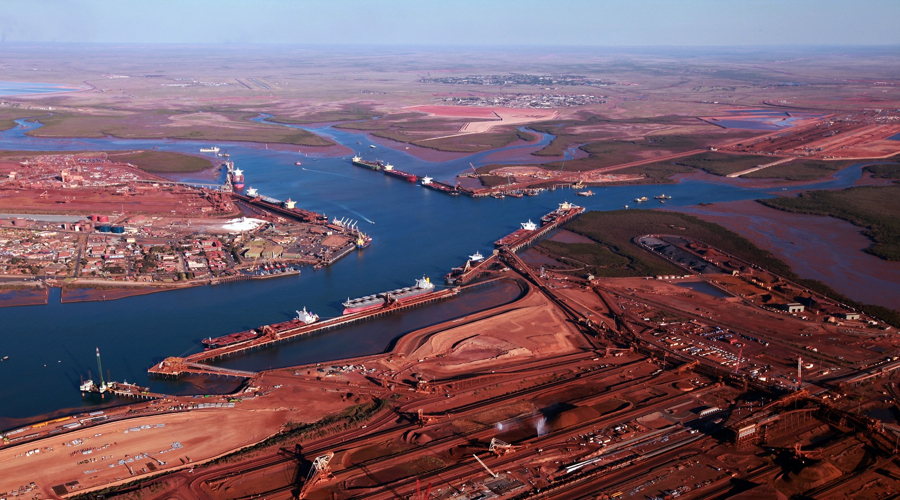
Australia’s iron ore exports rebounded in April after being hit by a cyclone the prior month, but the surge in shipments wasn’t enough to offset declining volumes from Brazil in the wake of January’s tailings dam disaster.
Australian exports were about 69.1 million tonnes in April, according to preliminary figures compiled by Refinitiv, based on vessel-tracking and port data.
This was up 20 percent from 57.5 million tonnes in March, when shipments were disrupted by Tropical Cyclone Veronica, which closed ports and impeded mining operations in Western Australia state.
Brazil’s exports volumes have been slipping since top miner Vale was forced to close several mines in the wake of the collapse of a tailings dam at its Brumadinho mine in late January, which left more than 300 people dead or missing.
Taken together, the total drop from the world’s top two shippers of iron ore in the first four months of 2019 is 35.7 million tonnes, a significant hit to global supply
Brazilian shipments of the steel-making ingredient fell sharply to 24.9 million tonnes in February from 30.1 million tonnes in January, the last month unaffected by the dam burst.
Exports slipped again to 23.5 million tonnes in March, and fell another 20 percent to just 18.7 million tonnes in April, the lowest monthly total since Refinitiv starting compiling data in January 2015.
In the first four months of 2019, Brazilian exports were 97.2 million tonnes, down from 111.9 million in the same period in 2018.
For Australia, exports in the first four months were 259 million tonnes, down from 280 million for the same period a year earlier, hurt mainly by a 13.3 million tonne drop in March.
Taken together, the total drop from the world’s top two shippers of iron ore in the first four months of 2019 is 35.7 million tonnes, a significant hit to global supply.
It’s therefore little wonder that spot iron ore prices have surged, and remained at elevated levels in recent weeks.
Ore with 62 percent iron content delivered to China, as assessed by Argus Media, was at $94.85 a tonne on Tuesday, the last day of April.
The price has now posted gains for five straight months, but the big kick up came in late January/early February, after the Brazil dam disaster, when prices jumped 20 percent between Jan. 25, the day of the burst, and Feb. 11, when they closed at $90.75 a tonne.
The Singapore Exchange futures curve has also shifted into a steeper backwardation since the Brazil dam collapse, with higher prices for prompt contracts indicating a tighter spot market.
As of the close on April 30, the front-month contract was trading at a 5 percent premium to the third month, up from a 3 percent premium the day of the Brazil incident. Like many major commodities, iron ore usually trades in backwardation.
The data on export volumes from Australia and Brazil, coupled with the price action, speaks to a sudden tightening of the market for seaborne iron ore.
What it doesn’t show is how likely this is to continue.
The data on export volumes from Australia and Brazil, coupled with the price action, speaks to a sudden tightening of the market for seaborne iron ore
The rebound in Australian exports in April likely shows that the cyclone disruption is over, and shipments will at least return to the recent monthly average, if not improve slightly, if the major companies are able to run their operations harder to make up for some lost ground.
The bigger question mark is Brazil, where it seems less likely that it can recover the tonnes lost so far.
Vale said on March 28 it expects to sell 75 million tonnes less iron ore and pellets this year, down 20 percent from 2018.
Given there isn’t much spare capacity in Australia, or in number three exporter South Africa, it’s difficult to see where these lost tonnes can be made up, other than at the margins by smaller exporters such as India and Iran, and by the use of port inventories in China.
But there are also some question marks over the strength of demand, particularly in China, which buys about two-thirds of seaborne iron ore and produces about half of the world’s steel.
China’s manufacturing Purchasing Managers’ Index (PMI) fell to 50.1 in April from March’s reading of 50.5, confounding market expectations that it would hold at the prior level.
While still just above the 50-level that separates growth from contraction, the PMI doesn’t provide confidence to hopes that China’s economy is starting to respond to Beijing’s recent stimulus moves.
It still may be the case that the economy will pick up from now on, but there is also a risk that steel demand forecasts may be too optimistic, and that iron ore demand may also moderate.
(By Clyde Russell; Editing by Richard Pullin)